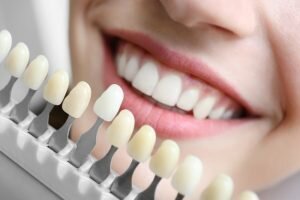
Which Teeth Whitening Procedure is the Best For You
Although the natural color of our teeth is not a true white, many people want that pure white Hollywood smile and try different teeth whitening methods to achieve that goal. Today, teeth whitening procedures are the most sought-after cosmetic and restorative dental treatments in Beverly Hills and throughout the U.S.
If you would like whiter teeth and a brighter smile, there are several different teeth whitening methods available:
-
Over-the-counter teeth whitening products:
-
Charcoal toothpaste (only useful for surface stains)
-
Teeth-whitening toothpaste
-
Teeth-whitening mouthwash
-
Teeth-whitening gels
-
Teeth-whitening strips
-
-
Professional whitening
-
Porcelain veneers
-
Porcelain crowns and bridges
For most people, Zoom! laser teeth whitening is the safest, quickest, and most effective option among the types of teeth-whitening treatments available. However, there are ultimately several ways to whiten teeth, and the most suitable option will depend on your timeline, budget, and priorities, as well as the nature of the discoloration.
Over-the-Counter Tooth-Whitening Treatments

For people who don’t want a professional treatment, teeth-whitening kits are available that use the same bleaching agent as professional teeth whitening. In most cases, the active ingredient is of a relatively lower grade, and it can take weeks to see any noticeable change.
Charcoal Toothpaste
Charcoal toothpaste is mostly ineffective, as it’s simply just more abrasive than regular toothpaste and does not address the issue of internal yellowing. However, if you have surface stains, a good toothpaste can address this type of yellowing issue.
Whitening Toothpaste
Whitening toothpastes typically use abrasive agents that polish your teeth along with a hydrogen peroxide bleaching agent to lighten the color of your teeth. Some whitening toothpastes use the chemical blue covarine to create the illusion of whiter teeth in a shorter amount of time. If you want to try a whitening toothpaste, look for a product with the American Dental Association Seal of Acceptance.
Teeth-Whitening Rinses
Mouthwashes or rinses that boast whitening powers have the same issue as toothpastes and whitening strips. They are more of a marketing ploy than a viable solution, but it’s sometimes hard to find a high-end paste or rinse without “whitening” properties. They are cheap nonetheless and do a decent job of maintaining a white smile between dental visits.
Peroxide-Based Whitening Gel
Gels are only a bit more effective than whitening toothpastes because of the peroxide present in the products. However, peroxide is only effective when it is in constant contact with the tooth. Unlike toothpaste, which is removed almost as soon as it’s applied, gel strips are pressed on, molded, and held in place for an extended time—giving the chemicals and peroxide more time to work.
Teeth-Whitening Strips
Compared to whitening gels, teeth-whitening strips are limited by their two-dimensional capabilities. The strips cannot mold around the creases between the teeth, leading the fronts of the teeth to appear whiter while the curved parts remain yellow. When bought over the counter, the strips are also not customizable, meaning that they will have extended contact with your gums and could cause soft-tissue pain or damage.
Professional Teeth Whitening
The teeth-whitening methods available through your dentist are more effective in making teeth bright and white than over-the-counter products. Dentists will typically use a stronger peroxide bleaching agent and special lights to whiten your smile. In addition, in-office whitening procedures can often make your teeth up to eight shades lighter with results that last up to a year-and-a-half.
Zoom! Laser Teeth Whitening
Currently, the preferred choice of tooth-whitening treatment is Philips' Zoom! laser teeth whitening. For laser teeth whitening, a patient will typically come in for an hour-long session and then use formulated take-home teeth-whitening trays for lasting results. Patients who want their teeth to be a brilliant white may choose to have multiple teeth-whitening sessions.
How The Laser Teeth-Whitening Process Works
In-office laser whitening uses a gentle dental-grade abrasive such as carbamide peroxide or hydrogen peroxide to break down the chemical bonds of the stains on the surface of the tooth. Then, laser light is introduced to activate the chemicals so that they start lightening the tooth immediately.
Advantages of In-Office Whitening
Professional treatments produce results that are immediate, noticeable, and safe, with your dentist overseeing your treatment every step of the way. Instead of spending money on over-the-counter treatments that don’t really work, dentists recommend investing in in-office teeth whitening for instant, effective, and lasting results.
Porcelain Veneers
For visible teeth that are too heavily stained for a whitening agent to remove the discoloration, porcelain veneers are a great alternative. Instead of applying chemical agents, a small amount of enamel is removed from the front of the teeth to make room for a tooth-shaped porcelain shell. Whereas professional whitening treatments aren’t permanent and need to be repeated annually, porcelain veneers don't stain and can last for up to 15 years—sometimes longer with optimal care.
Porcelain Crowns and Bridges
If you would like veneers but your teeth are too thin to support them, porcelain crowns and bridges could be a better fit. Rather than covering only the front of the tooth, porcelain crowns fit over the natural tooth structure like a cap. Where multiple crowns are needed in a row, a porcelain bridge can be used instead.
What Gives Teeth Their White Color?
For people considering teeth whitening, it's important to understand what gives teeth their color in the first place. Basically, the white comes from the thickness, or thinness of both the enamel and the dentin layer of the tooth.
If the outer enamel is thicker and the dentin has a much lighter composition, the appearance is a whiter tooth. However, if the enamel is thin, coupled with denser dentin, the result is a darker shade of white.
Why Our Teeth Become Yellowed
After years of drinking coffee, tea, and soft drinks and taking certain medications, our smiles can naturally become stained and yellow. This yellowing is natural, as it is the inner part of the tooth that yellows, not the outer enamel as most people think.
As we age, the outer enamel becomes thinner, and the inner part of the tooth becomes dark as it regenerates. Just as we get wrinkles and gray hair, our teeth yellow over time. There is nothing to be ashamed of about having yellowed teeth. However, many people opt for some sort of procedure to brighten their smile.
Consult With Your Dentist about the Best Way to Whiten Your Teeth
The most effective treatment you can receive through your dentist is Zoom! laser teeth whitening treatment. While this procedure is not the cheapest fix for yellowing, it is the most effective, quickest, and long-lasting procedure. If you are looking for the best brightening solution, Zoom! is it!
For patients who want an even longer-lasting solution or need structural reinforcement for their teeth, white-colored porcelain veneers, crowns, and bridges may be the best solution for a brighter smile. Not only do porcelain additions give you a whiter smile almost immediately, but they are also resistant to staining for permanently whiter teeth.
Whichever teeth-whitening method you choose, it's important to see an experienced cosmetic dentist before you start trying to whiten your teeth. Your dentist will be able to assess your oral health and recommend the safest and most effective solution based on your budget and goals. If your teeth are yellow, don’t skip the coffee. Skip the whitening strips, and visit your dentist for a customized whitening solution that actually works.
